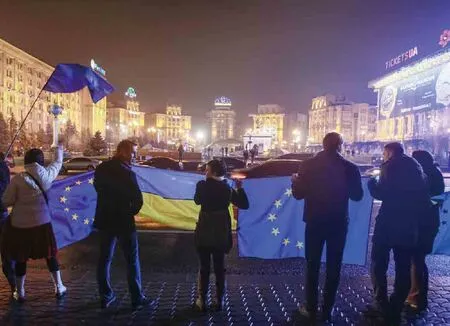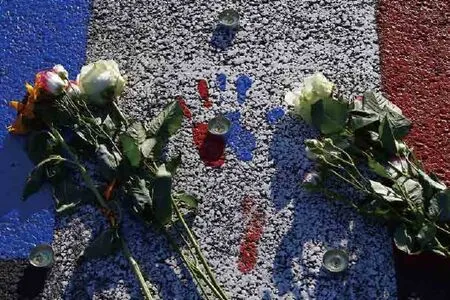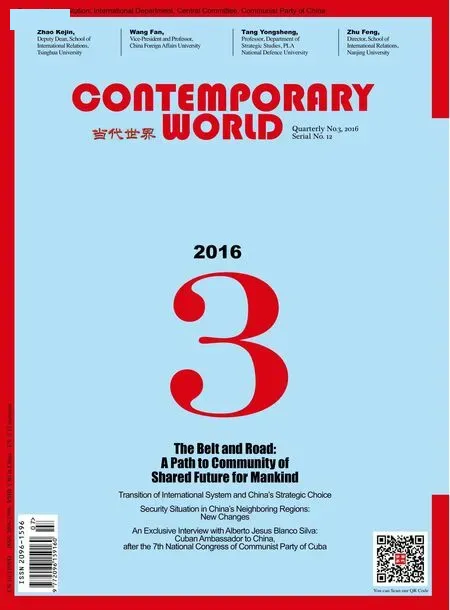Adjustment of EU Neighborhood Policy: From Value-Driven to Interest-Oriented
2016-09-20JiNLiNGFellowAssociateResearcherEuropeanResearchInstituteChinaInstituteofInternationalStudies
JiN LiNGFellow Associate Researcher, European Research Institute,China Institute of International Studies
Adjustment of EU Neighborhood Policy: From Value-Driven to Interest-Oriented
JiN LiNG
Fellow Associate Researcher, European Research Institute,China Institute of International Studies
As security in its neighborhood deteriorates, EU is making major adjustment to its Neighborhood Policy. The new policies are no longer value-driven,transformation-targeted, and single-handed, but more interest-oriented,flexible, differentiated and stability-targeted. The mode has been shifted from proactive export of democratic values, to reactive defense and damage control. The present goal is to “normalize” relations with its neighborhood.
PERipHERAl TURBUlENcE LEADs To PRoFoUND ADjUsTMENT To EU NEiGHBoRHooD PolicY
In 2004, EU for the first time published its Neighborhood Policy targeting 16 countries, with a view to building a prosperous and stable neighboring environment. Based on its own success story of expansion,the broad EU consensus is that EU will become the best model for future world order. Countries surrounding EU may not get a membership, but with the support and guidance from EU, they will be absorbed into the orbit of Europeanization, and a transformation path of free democracy and market economy. But 12 years later,EU’s neighborhood is turning into an“arch of turbulence”, and EU is in face of both traditional and non-traditional threats.
1. The Ukrainian Crisis Draws EU’s Attention Back to Traditional Security Concerns.
Currently, conflicts in eastern Ukraine tunes down, but tension between EU and Russia has yet to be fundamentally resolved. EU and US still hold on to sanctions, NATO increases military deployment to East Europe,and the air patrol above Baltic States is strengthened, all aimed to heighten deterrence against Russia. As reaction,Russia also resorts to sanctions, limiting import of agricultural produce from EU and the US and scaling up military inspection and drill in EU neighborhood. EU is convinced that Russia’s annexation of Crimea is an act to change sovereign borders by force and threat, which violates the international law and is against the Helsinki Process that has brought 40 years of peace and unity to Europe. Russia believes that no change has been made to Europe’s security mechanism since the end of Cold War, and it still attempts to contain Russia. It also believes that the Ukrainian crisis is a result of the West crossing the red line of Russian interests. The Crisis reveals cognitive difference between Russia and EU, and a realistic “security dilemma”.
2. Turmoil in West Asia and North Africa Exacerbates EU Non-traditional Threat.
After turmoil stroke West Asia and North Africa, EU made wrong judgments and changed its regional policy to actively and even militarily support the so-called “democratic process”. External intervention, border and ethnic conflicts, plus separatist forces in the region, the original “political ecology” of West Asia and North Africaare turned upside down. Various terrorist and extremist forces, especially the rise of the Islamic State (IS) have plunged West Asia and North Africa into chaos, directly impacting Southern Europe.

On 18 February, 2016,the EU convened the spring summit in Brussels,expecting to reach a consensus with UK on the EU reform scheme and strengthening its will of “staying in EU”. In addition, other hot issues such as the refugee problem, and the situation in Libya and Syria were also on the agenda. The picture shows Germany Chancellor Angela Merkel (left) and Greek Prime Minister Alexis Tsipras (right) were in a conversation.
3. Terrorist Threat Facing EU is on the Rise.
The IS, based on Islamic extremism and terrorism, has become a direct threat to European security. The biggest threat for Europe is the returning stream of jihadists from Syria and Iraq,whose number stands at 5000. The security risk posed by terrorism to Europe is no smaller than the Cold War. In 2015 Europe saw terrorist attacks increase in both number and scale. Copenhagen and Paris have become targets of attack for multiple times. Europe has been in panic ever since,with terrorist threat level upgraded in many countries. Terrorist threat facing EU is spontaneous, home-grown,scattered, cross-bordered, and internetbased, making it harder to fend off.
4. EU Faces Severe Crisis of Illegal Immigrants and Refugees.
Turmoil in West Asia and North Africa not only brings threat to Europe,but also triggers humanist disasters in the Middle East. Pressure brought by illegal immigrants and refugees to South Europe is mounting. According to statistics, in 2015 about 1.5 million illegal immigrants and refugees entered Europe through Mediterranean Sea, mounting shocks not only to Europe’s security and unity, but also the Schengen Agreement, which is the foundation of European integration.
EU SEARcHiNG FoR AN INTEREsTORiENTED NEW NEiGHBoRHooD PolicY
Since war broke out in West Asia and North Africa in 2011, EU has made some modifications to its Neighborhood Policy. The principle of reform for assistance has been raised, hence increasing support for neighboring countries’ democratic transformation. But the persistent turbulence afterwards propelled EU to rethink its neighborhood policy. After internal consultation for a year, in November 2015 EU Commission rolled out the new neighborhood policy paper, defining the orientation, priority and principle of EU neighborhood policy. The fundamental change is to stop measuring others with the EU yardstick,and search for common interest, in the mean time tuning down ideology and upholding “interest exchange”principle, pragmatically develop nor-mal partnership with all neighboring countries.

The Ukrainian Crisis draws EU’s attention back to traditional security concerns. The picture shows the protesters were holding up flag of Ukraine and flag of EU to express their support of Ukraine-EU integration on the street of Kiev.
1. “Stability” Replaces “Transformation” to Become the Core Goal for Neighborhood Policy.
EU Neighborhood Policy formulated in 2004 has shown all its defections,as EU hasn’t been able to export its own model, but got itself raveled in a chaotic mess. Traditional security and non-traditional security threats are on the rise, especially the terrorist risk and refugee crisis, which push EU to prioritize stability over transformation. According to the EU Neighborhood Policy communication paper: the top concern for EU Neighborhood Policy for the next 3-5 years is “stability”,therefore the emphasis put on security cooperation including that on conflict prevention, border management, antiterrorism, and anti-extremism. This is a major adjustment of the Neighborhood Policy.
2. A Reasonable Recognition of Diversity in Its Neighborhood and Its Limited Capacity to be the “Transforming Force” Leads to a Differentiating and Flexible Policy.
EU Neighborhood Policy used to differentiate East and South Europe,but this only reflects different policy priorities of member state, rather than differentiated policy targeting different regions and countries. EU is clearly aware that not all of its neighbors are ready to be in deep interaction with the union. The “strings attached” have limits in promoting political transformation. As neighboring countries fall into chaos and instability, EU gradually realizes that the EU model is a “controversial” one. The EU new neighborhood polity communication paper points out that the new neighborhood policy will workunder the principle of “differentiation”and explore different ways of cooperation with relevant countries. For those whose are unwilling to enhance cooperation under the current mode,the EU will find alternatives to step up trade and investment ties in a view to realizing mutual benefit.
3. With the Introduction of the“Neighborhood’s Neighborhood” Concept, the New Neighborhood Policy is More Open.
Although EU always sees neighborhood policy as a tool to promote“modernization” of neighboring countries, down tuning its character as a geopolitical instrument, both its transformation goal and policy methods are “exclusive”. The Ukraine Crisis has clearly shown that neighborhood policy, especially the policy targeting eastern neighborhood is “geopolitical”. EU finds it difficult to handle the neighborhood chaos alone, for its policy leverage also has limits. More cooperation is called for to build broader ties. Thus the new neighborhood policy expands its scope of peripheral realm,and introduces “Neighborhood’s Neighborhood” concept, emphasizing international cooperation and jointly coping with challenges. According to the new neighborhood policy, based on mutual connection and reliance,countries need broader cooperative format, with third parties participating in the cooperation.
INFlUENcE oF THE NEW NEiGHBoRHooD PolicY
Though the new neighborhood policy will not come into effect at once, it will become an important part of the EU global strategy. Its orientation and principles will directly impact its external behaviors, especially those related to Russia and Pan-African Region.
1. Conducive to Improvement of EURussian Relations.
The new neighborhood policy is interest-oriented and stability-based,thus providing opportunity for EURussian Relations to improve. The policy’s priority on security and stability increases room for cooperation and dialogue. Rise in regional cooperation also pushes for more possibility of EURussian cooperation in the region. In its security environment assessment,EU has made “rebuilding European security structure with Russia” as its priority in shaping neighborhood security.
2. Step up Pragmatic Adjustment of EU-African Relations.
In its strategic assessment report,the European External Action Service(EEAS) states the need to redefine EUAfrican relations. With the introduction of “Big Neighborhood” concept,many African countries are included into the scope of EU neighborhood. Many pragmatic principles in EU new neighborhood policy will find expression in its African policy, propelling adjustment from value-driven to interest-oriented. Currently, the most obvious change takes place in EU assistance to Africa. For a long time, EU uses assistance as leverage to promote democratic transformation. Now EU hopes to exchange aid for African cooperation in maintaining stability and handling immigration. In the 2015 EU-African Immigration Summit, EU is willing to set up a 1.8 billion Euro Trust Fund. It is clear that in the future EU-African relations will be refocused from assistance to cooperation in trade, security and immigration.
3. Expand Opportunities for China-Europe Cooperation.
EU neighborhood is a major region for China’s “Belt and Road” advocacy. Either EU-Russia tension or turmoil in West Asia or North Africa is conducive to the implementation of “Belt and Road” strategy. EU seeks to build partnership based on common interest,introduces “Neighborhood’s Neighborhood” concept and the new pragmatic neighborhood policy aimed to expand international cooperation. All these moves have to some extend forsake traditional neighborhood policy that is exclusive and driven by value. Thus EU’s foreign philosophy is more in line with China’s, which targets multilateral cooperation. This presents new opportunities for China-EU cooperation in EU neighborhood.

Since 2015, Europe saw terrorist attacks increase in both number and scale. Copenhagen and Paris have become targets of attack for multiple times. The picture shows people were mourning the victims suffered on Bastille Day (July 14th), Nice, with flowers and candles on the way colored with French flag on July 17th, 2016.
杂志排行
Contemporary World的其它文章
- Distorting History Is Not Tolerable: An Interview with Soga Yuji, President of Japan-China Friendship Association for the 21st Century
- An Exclusive Interview with Alberto Jesus Blanco Silva: Cuban Ambassador to China, after the 7th National Congress of Communist Party of Cuba
- Analysis of the Rise of Spain’s“We Can” Party
- Prospects of Solution to Syrian Crisis
- Sharp Changes Took Place in Political Structure of Latin-American Countries: Causes, Impacts and Prospect
- “Thucydides Trap” and China-US Relations
